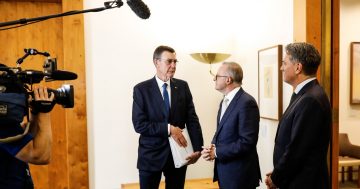
Defence Minister Richard Marles at Wednesday’s launch of the NDS and IIP. Photo: ADF.
Like many Defence observers and commentators, I eagerly tuned in to Defence Minister Richard Marles’ address to the National Press Club on Wednesday to hear all about the government’s inaugural National Defence Strategy (NDS) and an update of the accompanying Integrated Investment Plan (IIP).
While last year’s Defence Strategic Review (DSR) laid out the government’s intent, the NDS and IIP are designed to provide the pathway to achieve that intent.
But the speech – and the documents’ contents – were somewhat underwhelming.
In particular, compared to its Defence Capability Plan (DCP) predecessor of a decade ago and the first iteration of the IIP in 2016 – supposedly a living document but never publicly updated – the new IIP lacks any real detail.
The “inaugural” NDS isn’t really a new document; it’s just a new label.
Each government likes to conduct a defence capability review which the Defence Minister of the day can hang his or her hat on. It may have a different name on the wrapper, but like previous papers before it, it really just seeks to update Australia’s strategic circumstances and re-align the ADF’s capabilities and priorities to those of the government.
That said, the Morrison Government’s 2020 Defence Strategic Update (DSU) and accompanying Force Structure Plan (FSP) was eye-opening in that, for the first time, it articulated publicly what many in Defence already knew.
It said the previous 10 or more years warning time Australia could expect to have of any significant geostrategic changes in the region had significantly narrowed. It said new capabilities, such as long-range missiles for all three services and a 30 per cent boost in uniformed personnel numbers, would be required.
However, no doubt, due in part to financial constraints directly related to the pandemic, the DSU was never funded appropriately, and little was done in the following two budgets to halt the drain of talent from the ADF.
Leaving AUKUS aside, the Albanese Government’s commissioning of its own Defence Strategic Review (DSR) took more than six months to be delivered. That was followed by the independent naval surface fleet review, which took another six months. And now, another six months later it has delivered the NDS and IIP.
So, we’re now four years into that decade Morrison’s 2020 DSU and FSP had warned us about, but we’re effectively in the same place.
The NDS and IIP—apart from some detail on funding and project rescoping or cancellations—are really just a compilation of a number of project announcements the government has made over the past 18 months or so.
For example, in 2022, Defence switched to a new recruitment provider and last year appointed a dedicated three-star officer to lead recruitment. It also offered retention bonuses and better defence housing benefits and is rolling out a new recruitment advertising campaign.
But right now, the ADF has 4500 fewer people than it needs, and in a period of almost full employment, it isn’t easy to see where the future workforce will come from.
This is arguably the ADF’s most significant risk, highlighted by the fact that the Air Force has fewer pilots than it has operational aircraft, and the Navy will decommission two of its eight Anzac frigates years earlier than expected because it simply cannot crew them.
For other capabilities highlighted in the NDS and IIP, the government has already made several announcements in the past 18 months.
Announcements already made include long-range air, sea and land-launched strike and anti-ship missiles for all three services. The Guided Weapons and Explosive Ordnance (GWEO) ambitions of the previous government have progressed, with agreements now in place to assemble and hopefully manufacture GLMRS rounds and other weapons in Australia from next year.
For Army, announcements have already been made on a new class of amphibious landing craft to be built in Australia, and there has been a down select but reduction in numbers of infantry fighting vehicle, and a halving of the planned buy of self-propelled artillery vehicles.
The February release of the independent analysis of the Navy’s surface combatant fleet already revealed the Navy’s plans for an expanded fleet of new crewed and optionally crewed surface ships, the scaling back of the Hunter class frigate and Arafura class OPV buys, and the early decommissioning of two Anzac frigates.
There was some clarity in the NDS on basing.
We already knew that northern bases such as RAAF Bases Townsville, Scherger, Tindal, Darwin, Learmonth and Curtin, and naval bases at Cairns and Darwin would all receive upgrades to make them more resilient due to their remoteness, climate change and risk of possible attack.
But it now appears more than $1 billion will come from funding earmarked under Projects EST 207 and EST 105 to upgrade other Defence infrastructure, particularly in Canberra. These include buildings in Russell, Duntroon, Campbell Park, HMAS Harman and ADFA, but not the progression of new ADFA live-in accommodation.
Campbell Park and some of the buildings at Russell, in particular, are already marginally fit for purpose at best, so it remains to be seen how the planned growth of the ADF’s uniformed and public service workforce will be accommodated in the future.





















